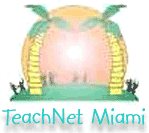

|
Around the World in 8 Days, Olé How It Works: Around the World in 8 Days, Olé is a simulation
cooperative project specifically designed to learn about Hispanic countries,
their culture, and its currency through the use of the Internet. It is based
on interactive units that will build students’ research skills. The purpose
of this project is to integrate reading, writing, math, social studies, and
technology using a collaborative model where groups of students will be able
to work, research and create a presentation. An Introduction leads the teacher
to guide students into the project. The students will be able to have fun
surfing the Internet while acquiring information on the Hispanic country they
have selected. Students must complete a series of six activities during this
simulation of a worldwide tour. A series of Activities guide the students in
their search for information. Each activity has specific links that make it easy for
beginners to navigate without difficulty, as well as allow high tech students
t! o create a unique presentation using their wildest imagination. Once
students reach a particular site, it is up to them to gather the information
to be used in the presentation. However, the sites used are on-line
interactive sites such as Yahoo and The Web of Culture, where authentic data
is gathered. A sample lesson consists of easy to read, comprehend, and follow
step-by-step directions. For example, students have to measure the distance
from two cities. A link to Maps.com takes the students to the site where they
will be able to have access to a map to measure the distance. As a culminating
activity, using the data collected, each group to will present orally,
written, or through an authoring program, such as HyperStudio, PowerPoint or
iMovie, with the end goal of persuading their classmates to vote for their
travel plans. After all presentations are made, the class is to evaluate the
groups using a rubric and then vote for the best itinerary. Standards:
Estimated Class Periods To Complete: 10 or more Software Materials Used: Students need to have access to the Internet. They need a
word processing program such as Publisher, Microsoft Office, Word, or Apple
Works to copy and paste information, graphics, maps, graphs, etc. to their
document. They need a printer and a scanner or digital camera for embedding
information brought from other sources. A digital video camera is a must for
iMovies. A presentation program such as iMovie, PowerPoint, Inspiration,
HyperStudio, or the like is needed to produce the final presentation. Hispanic, Culture, Measurement, Money, Social Studies,
Multicultural, Currency, Simulation Students: This project is designed for third and fourth grade
students. Overall: The most valuable feature of this project is that students
will be engrossed in learning a variety of skills while having fun creating,
collaborating, and producing authentic projects. When students are involved in
hands-on self-motivated activities, self-esteem is raised, consequently
increasing student achievement. When learning is meaningful it becomes long
lasting. Effective uses of new media include the integration of the latest
technologies with the curriculum, replacing sometimes outdated and boring
textbooks. Using online inquiry students can receive up to the minute
information, making learning exciting and meaningful. Tips: |
About the Teacher: Rosa Duarte is in her 25th year in Miami Dade County Public Schools. Holding a Master’s Degree in ESE, she specialized in autism. She was a Staffing Specialist in Region 4 and a District Support Teacher for the Autistic Program. She received her Educational Specialist in Computer Applications and in 1996, became the Technology Coordinator/Computer Teacher at Southside Elementary where she teaches the Academic Excellence Program as well as computers to K-5 students. As Webmaster, she publishes their Southside Express and has been awarded a Success Grant, the Citibank FamilyTech Grant from the Ed Fund, and AT&T Grants. Subjects: General Elementary and Math Grade Levels: 3-4
|
What do you think of my
project? I'd really like to hear your opinion -
Click here for a very brief survey.